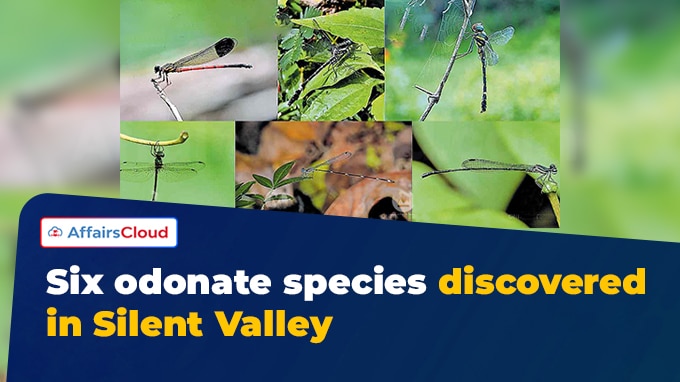In October 2025, Six new species of dragonflies and damselflies (odonates) have been discovered in Silent Valley National Park, Kerala, during a three-day odonate survey jointly organised by the Silent Valley National Park and the Society for Odonate Studies (SOS) from October 10 to 12, 2025.
Exam Hints:
Discovery 1:
- What? Six New Odonate Species Discovered
- Where? Silent Valley National Park, Kerala
- When? Survey conducted from October 10-12, 2025.
- Total Species Recorded: 83 species
- Newly Reported Species: Long-legged Clubtail, Fraser’s Torrent Hawk , Dark Daggerhead, Blue-necked Reedtail, Wayanad Torrent Dart, and Black & Yellow Bambootail.
- Park’s Total Odonate Count: Increased from 103 to 109 species
Discovery 2:
- What? Discovery of new snail species
- Where? Tilari forest, Kolhapur, Maharashtra
- Scientific Name: Lagocheilus hayaomiyazakii sp. Nov.
- Significance: First record of genus in northern Western Ghats; honours Hayao Miyazaki
Key Findings:
Survey Findings: A collaborative survey was conducted across 12 campsites by volunteers, forest staff, and the Society for Odonate Studies recorded 83 odonate species in Silent Valley National Park, including six newly reported species previously unrecorded in the area.
6 Newly Discovered Species:
- Long-legged Clubtail (Merogomphus longistigma)
- Fraser’s Torrent Hawk (Macromia irata)
- Dark Daggerhead (Macromidia donaldi)
- Blue-necked Reedtail (Protosticta mortoni)
- Wayanad Torrent Dart (Euphaea wayanadensis)
- Black and Yellow Bambootail (Elattoneura tetrica)
About Odonate :
Ecological Significance: Odonates, comprising dragonflies and damselflies, act as bioindicators by providing insights into freshwater ecosystem health, including habitat quality, pollution levels, and overall ecological balance, as observed in Silent Valley.
Indicator Species: The presence of three Euphaea species and endemic odonates like Protosticta and the Saffron Reedtail (Indosticta deccanensis) indicates Silent Valley National Park’s pristine freshwater quality and its role as a refuge for endemic species.
Odonate Diversity: The park’s known odonate count increased from 103 to 109 species, reflecting the presence of diverse microhabitats capable of supporting this rich biodiversity.
Conservation Efforts:The fourth odonate survey since 2019, led by Dr. Sujith V. Gopalan, Vivek Chandran, Mr. Muhamed Sherif, Renjith Jacob Mathews, and Reji Chandran, documented Silent Valley’s biodiversity, with a fifth survey planned for 2026.
New Hairy Snail Species Discovered in Maharashtra
In October 2025, researchers from Thackeray Wildlife Foundation, in collaboration with Dr. Dinarzarde Raheem of Rajarata University, Sri Lanka, discovered a new species of land snail in the semi-evergreen Tilari forest, Kolhapur district, Maharashtra.
- The species has been named Lagocheilus hayaomiyazakii species nova (sp. nov.) (new species), commonly known as the Tilari hairy snail, in honour of Hayao Miyazaki, Japanese animator and co-founder of Studio Ghibli.
- The research findings were published in the Journal of Conchology by the Conchological Society of Great Britain and Ireland.
About Discovery of Hairy Snail Species:
Identification: Based on 12 collected specimens and detailed photographic and Scanning Electron Microscope (SEM) analysis of shells, apertures, and periostracal hairs.
Geographical Significance: Lagocheilus hayaomiyazakii marks the first record of its genus in the northern Western Ghats, extending the known distribution 540 kilometer (km) north into the Indian Peninsula and highlighting the region’s underexplored biodiversity.
Habitat: Lagocheilus hayaomiyazakii inhabits semi-evergreen Tilari forests, dwelling in leafy thickets and rocky floors, with a pointed-apex shell covered in periostracal hairs that may aid camouflage, reduce damage, or transport pollen and seeds.
Scientific Importance: Lagocheilus hayaomiyazakii, part of a genus comprising 106 species across South and Southeast Asia, with only six previously recorded in mainland India





